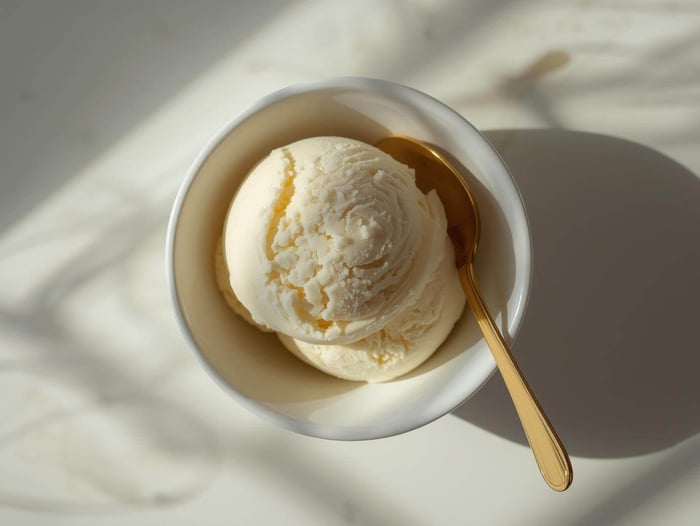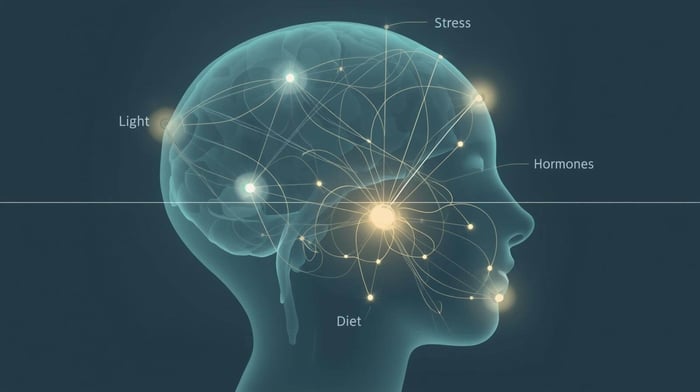Table of Contents
- At a Glance
- Can Dairy Really Cause Migraines?
- The Science Behind Dairy and Migraines
- Which Products Are Most Commonly Reported as Dairy Migraine Triggers?
- What If You Notice a Pattern?
- Additional Factors to Keep in Mind
- Dietary Management and Broader Support
- Questions You Might Have
- Does cutting out all dairy stop migraines?
- Are some cheeses worse than others?
- Is lactose intolerance the same as a dairy migraine trigger?
- Can dairy allergy cause migraines?
- Can dairy-related inflammation trigger migraines?
- Can dairy-free alternatives trigger headaches?
- Should I try a dairy elimination diet?
- Final Thoughts
At a Glance
|
You might have noticed a headache or migraine coming on after eating cheese, drinking a glass of milk, or even when indulging in ice cream. This might make you wonder, can dairy cause migraines, and whether cutting it from your diet may make a difference.
The answer isn’t the same for everyone. For some, certain dairy products may act as a trigger, while others can enjoy dairy without any problems at all.
In this article, we’ll look at why dairy may act as a possible migraine trigger, what the science says about it, and ways to recognize if dairy affects your migraines.
Can Dairy Really Cause Migraines?
Dairy is a commonly mentioned food group associated with migraines. This is largely because it is found in so many everyday meals, and many milk products, especially aged or fermented ones, contain compounds such as tyramine and histamine that have been linked to headaches.
Consuming milk-based foods does not always lead to migraines. Some people observe a link, while others notice no connection at all. The important point is that this food group contains many suspected triggers, making it both a topic of research and something to take into account when trying to better understand your own migraine triggers.
Research findings on the link between dairy and migraine are mixed, and several large reviews note there is no consistent evidence that dairy directly causes migraines for most people.

The Science Behind Dairy and Migraines
Tyramine and Histamine in Aged or Fermented Dairy
Aged cheeses, yogurt, kefir, and sour cream can contain relatively high levels of compounds such as tyramine and histamine, which are associated with migraine triggers (Finocchi & Sivori, 2012). These substances are vasoactive, meaning they can influence how blood vessels expand and contract, processes that are often linked to headache onset in research.
Not everyone is sensitive to these compounds, but for those who are, consuming these foods in moderation, or even removing them from your diet, may provide insight into whether they are linked to your migraines (Millichap & Yee, 2003).
Inflammatory and Vascular Effects
In addition to pathways affected by tyramine or histamine, several biological mechanisms have been proposed to explain how dairy might influence migraine activity. These include inflammatory and vascular processes, such as changes in blood vessel tone, platelet activity, and the release of signaling molecules that affect pain pathways (Akgör et al., 2024). Some research also links gut–brain interactions, suggesting that dairy intolerance or sensitivity may contribute to inflammation and changes in neurotransmitter balance (Mugo et al., 2025). While these ideas remain theoretical, they highlight the complex ways diet can interact with migraine biology (Gao et al., 2025).
Milk Proteins: Casein and Whey
Milk proteins such as casein and whey are sometimes discussed in relation to migraine. These proteins are known to provoke immune or inflammatory responses in people with milk allergy or sensitivity, which raises the question of whether they might also influence migraine risk in certain individuals. While direct evidence is limited, some reviews note that dairy proteins could contribute to inflammatory pathways relevant to headache disorders (Finocchi & Sivori, 2012; Martins et al., 2020).
Not everyone reacts to casein or whey, and for many people, these proteins are well tolerated. For those who suspect a connection, paying attention to how milk products affect their symptoms may provide insight into whether protein sensitivity has a role in their migraines.
Lactose Intolerance and Migraine
Lactose intolerance occurs when the body does not produce enough of the enzyme lactase to properly digest milk sugar. This can lead to bloating, cramps, and other digestive discomfort after consuming dairy. While these symptoms do not directly cause migraine, they may add stress to the body or disrupt daily routines, which can lower the threshold for an attack.
Some reports use the phrase lactose intolerance migraine to describe situations where digestive distress seems to coincide with headache. Research on this link is limited, and the connection is not as well established as with compounds like tyramine or histamine (Finocchi & Sivori, 2012). Still, for individuals who notice both digestive upset and migraine after consuming dairy, it may be helpful to consider lactose intolerance as one possible factor, alongside other secondary conditions linked with migraine.
Elimination Diet Studies
Elimination diets are often used in migraine research to help identify whether certain foods act as triggers. Dairy products are frequently included among the foods removed during these trials. Some participants report fewer migraine attacks after cutting out dairy, while others notice no difference at all (Alpay et al., 2010).
A recent review highlights the potential role of dairy in headaches and points to tyramine, histamine, and specific milk proteins as possible contributors in sensitive individuals (Derman & Doğru, 2024). These mixed findings suggest that dairy is not a universal trigger but may be relevant for certain individuals. Tracking your own response to dietary changes, whether through a structured elimination plan or personal observation, remains the most reliable way to assess whether dairy is connected to your migraines.
Which Products Are Most Commonly Reported as Dairy Migraine Triggers?
Not all milk-based foods affect people in the same way. Some are more commonly reported as dairy migraine triggers, while others appear less likely to play a role.
Aged Cheeses
Aged cheeses such as cheddar, parmesan, and blue varieties are the dairy products most often mentioned in connection with migraines. They are relatively high in tyramine, which may make them more likely to cause problems for those who are sensitive. If you enjoy cheese, you might consider trying less mature cheddars or alternatives such as sheep and goat cheeses.
Fermented Dairy
Yogurt, kefir, and sour cream can be high in histamine and other biogenic amines produced during fermentation, such as tyramine. These substances are discussed in research as possible contributors to headaches, but sensitivity varies from person to person. If you enjoy fermented dairy, you may find that fresher products or those with shorter fermentation times are easier to tolerate compared with strongly aged or cultured varieties.
Cream and Ice Cream
Cream and ice cream do not usually carry the same histamine or tyramine load as aged or fermented dairy. However, their high fat and sugar content can cause rapid shifts in blood sugar and digestion, which some people find lowers their migraine threshold. If you notice issues after these foods, trying smaller portions or choosing lower-sugar varieties may help you see whether they play a role in your symptoms.

Fresh Milk
Fresh milk is less often linked to migraines than aged or fermented dairy, since it has lower levels of tyramine or histamine. Although lactose intolerance or sensitivity to milk proteins like casein and whey may not trigger migraine on their own, the digestive stress they create may make attacks more likely. If you suspect milk is a factor, keeping track of both digestive symptoms and migraines can help highlight any connection. Some studies also suggest that low-fat or skim milk may be linked with fewer migraines, though results remain mixed.
What If You Notice a Pattern?
If you think dairy might be affecting your migraines, the first step is to pay close attention to how you feel after eating certain foods. Keeping a food and symptom diary can help you spot connections that might otherwise be missed.
Some people find it useful to try an elimination and reintroduction approach. This means removing dairy from your diet for a few weeks, then reintroducing it carefully to see whether your symptoms change.
The key to determining whether dairy is a factor is to look for consistent patterns, not one-off events. A single headache after eating ice cream may not mean much, but repeated problems after eating the same foods can suggest a clearer link.
Additional Factors to Keep in Mind
Even if you find that dairy plays a part in your migraines, how it affects you can depend on several factors. These include:
Portion size: Larger servings raise the amount of potentially irritating compounds like tyramine or histamine. You may find that a little cheese or yogurt is fine, but bigger portions cause more trouble.
Other triggers: Dairy can sometimes add to other migraine triggers such as stress, hormonal changes, or poor sleep. This overlap can make it harder to know whether food alone is responsible.
Type of product: Fresh milk and lightly processed options tend to have fewer trigger compounds than aged cheeses or heavily fermented foods. The degree of processing can affect how likely that food is to trigger symptoms.
Dietary Management and Broader Support
Dairy is only one piece of the puzzle and rarely the sole reason migraines occur. Many people find that broader nutritional and lifestyle changes can make a real difference in managing their migraines. Maintaining steady hydration, regular meals, balanced sleep, and limiting known triggers can work together to reduce attack frequency and intensity.
These simple steps form a strong foundation, which can be supported further through targeted nutritional support.
If you’re focusing on nutritional support beyond dairy, Brain Ritual® was developed to strengthen the systems that help keep migraine triggers in check. One of the key things that sets it apart is its inclusion of ketone bodies, providing an efficient alternative energy source for the brain when glucose use becomes less stable. Brain Ritual® ingredients include L-carnitine and choline, which help maintain healthy energy metabolism and nerve function, while zinc, selenium, and vitamins A, C, and E support antioxidant and immune balance, areas that may be affected when diet or digestion feels off. The formula also provides magnesium, sodium, and potassium, key electrolytes that support hydration, nerve signaling, and muscle balance, all important for maintaining stability during daily migraine management.
Together, these nutrients work to sustain steady energy, hydration, and resilience, giving your brain the nutritional foundation it needs to perform at its best. You can purchase Brain Ritual® here.
Disclaimer: Brain Ritual® is a medical food for the dietary management of migraine and is not intended to diagnose, treat, cure, or prevent any disease. This content is for informational and educational purposes only and is not intended as medical advice.
Questions You Might Have
Does cutting out all dairy stop migraines?
Not necessarily. While some people report fewer attacks after removing dairy, others see no change. Migraine is usually influenced by several factors, and diet is only one of them. The best approach is to monitor your own reactions and look for consistent patterns over time.
Are some cheeses worse than others?
Yes, aged cheeses such as cheddar, parmesan, and blue cheese are more likely to trigger symptoms because they contain higher levels of tyramine, a compound associated with migraine sensitivity. Milder or less-aged options tend to be easier for many people to tolerate.
Is lactose intolerance the same as a dairy migraine trigger?
No. Lactose intolerance causes digestive symptoms like bloating or cramps, while a dairy migraine trigger is more about how certain compounds or proteins affect the nervous system or inflammation. However, digestive stress from lactose intolerance may lower your migraine threshold, which is why some people notice both issues together.
Can dairy allergy cause migraines?
A dairy allergy involves an immune reaction to milk proteins such as casein or whey. Although it is different from lactose intolerance, the resulting inflammation can sometimes worsen headache or migraine symptoms in sensitive individuals. This connection is not universal but may be worth exploring if you experience both allergic symptoms and migraines.
Can dairy-related inflammation trigger migraines?
Possibly. Some research suggests that immune or inflammatory reactions to dairy proteins may, in some individuals, affect blood vessels or pain-related pathways in the brain. However, this connection has not been proven, and most people tolerate dairy without an inflammatory response.
Can dairy-free alternatives trigger headaches?
Sometimes. Dairy-free products can still contain additives, thickeners, or sweeteners that may act as triggers for certain people. Ingredients such as carrageenan, guar gum, and xanthan gum are common in non-dairy milks and creamers and can sometimes cause digestive upset, which may lower migraine tolerance. Artificial or high-intensity sweeteners like aspartame and sucralose have also been reported as migraine triggers for some people. Be sure to check ingredient labels and track your response to individual products rather than assuming all alternatives are the same.
Should I try a dairy elimination diet?
An elimination diet can help you identify whether dairy or other foods contribute to your migraines. This involves removing dairy for a few weeks, then reintroducing it gradually, starting with one type at a time such as milk, yogurt, or cheese, to observe any changes. It is best approached systematically and alongside other lifestyle factors such as sleep, hydration, and stress management.
Final Thoughts
Consuming dairy products can affect people with migraine in different ways, and current research continues to explore why some individuals are more sensitive than others. For some, aged or fermented products such as cheese or yogurt may act as triggers, while others can enjoy them without any problem. It is important to keep track of how it affects you, rather than assuming dairy is automatically off-limits.
By tracking what you eat, how you feel, and when symptoms occur, the potential links between dairy and migraine symptoms can become clearer. If dairy seems to play a role, it is worth trying small adjustments, such as choosing fresher products or reducing portion size, as these may help to lessen discomfort without needing to cut dairy out entirely.
Dairy is just one factor among many that can influence migraine. While identifying specific food triggers can be valuable, maintaining good hydration, consistent meals, and balanced nutrition tends to support general migraine resilience.




